| 1 | Malabar pitviper |
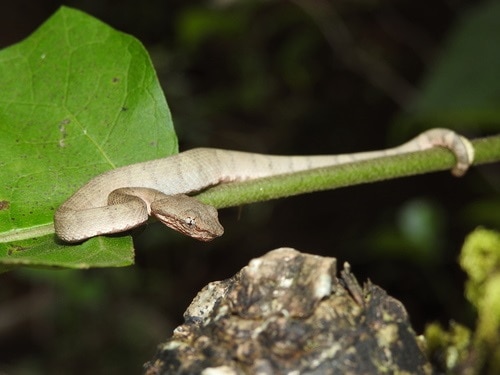
A constantly shifting snake which can be green, brown or even blue. Malabar pitvipers have endless morphs, and inhabit India’s damp western Ghats mountain range. They’re a branch dweller which also appears on roofs of old buildings, and can go months without moving. They possess infrared heat sensing pits which can detect temperature differences of 0.001 degrees. All this goes to one purpose: hunting treefrogs. About 75% of their diet consists of frogs and toads, and particularly one species, the Malabar gliding frog.
Malabar pitvipers are ambush predators and wait until frogs are just a short distance away before striking, often ten metres. They swallow their prey in 5-10 minutes, a meal which can last for months. It’s typically 2 weeks before they enter active ambush posture again. Other confirmed prey in India’s evergreen forests include Indian bullfrogs and bicolored frogs.
Malabar pitvipers don’t completely shun mammals, with the Asiatic long-tailed climbing mouse being one confirmed prey, but amphibians dominate. As long as you don’t stand between Malabar pitvipers and their frog prey, you should coexist peacefully with this venomous snake.
| 2 | Red-bellied black snake |
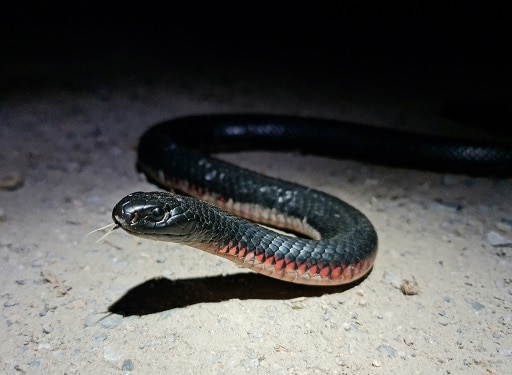
The red-bellied black snake caused 16% of Australian snakebites from 2005 to 2015, but at least they’re not figuring out ways to eat us. This venomous species shuns mammals and mainly eats frogs, matching its habitats of ponds and riverside pools, with a few reptiles too. The emerald tree frog is a confirmed meal, which they acquire using active foraging rather than ambush tactics. Red-bellied black snakes are a highly energetic species, as one radiotracked individual even slithered 1.22km in a single day. They love frogs so much that they swallow them too quickly; one red-bellied black snake was forced to regurgitate its meal as the venom hadn’t even kicked in yet.
It appears that red-bellied black snake venom is tailored against frogs. In 1981, scientists identified a unique neurotoxic called pseudexin, yet the venom isn’t known for neurotoxic symptoms in humans. The toxin may only block the brain signal receptors of amphibians.
Their diet also backfired in the 1930s, when the poisonous cane toad invaded Australia. Red-belly populations plummeted rapidly, as the surprise bufotoxins stopped their heart. Populations particularly fell in New South Wales through the mid-20th century, but red-bellies have rapidly evolved in response. Their heads have shrunk, so that cane toads don’t fit through, a few have gained outright resistance, and in some regions the toad-loving taste buds are dying out.
| 3 | Small-spotted cat-eyed snake |
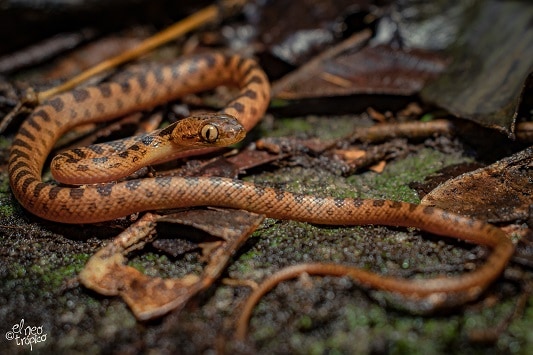
The small-spotted cat-eyed snake is a thin branch leaper, which spends 90% of its time in trees and strays to the ground occasionally. They range from Honduras to southern Mexico, sticking to forests and tree clumps in rural villages. Here, they’re the number 1 nemesis of the local treefrogs. Confirmed prey in the wild include Morelet’s tree frogs, gulf coast toads, and hourglass tree frogs. They also feast on frog eggs, located on nooks in gnarly tree trunks.
Leptodeira polysticta is no threat to humans, but possesses a milder venom which rapidly disables their smaller frog prey. The frogs don’t instantly accept their fate though, as they’ll inflate their bodies like a balloon to avoid being swallowed.
Tree frogs also alert their fellow kind when Leptodeira polysticta draws near, by issuing frantic distress calls, in a form of amphibian language. This is a classic snake where their forests seem peaceful, but in reality, there’s constantly battles, duels of wits and epic wrestling matches happening under everyone’s noses, between tree snakes and frogs.
| 4 | Common keelback |
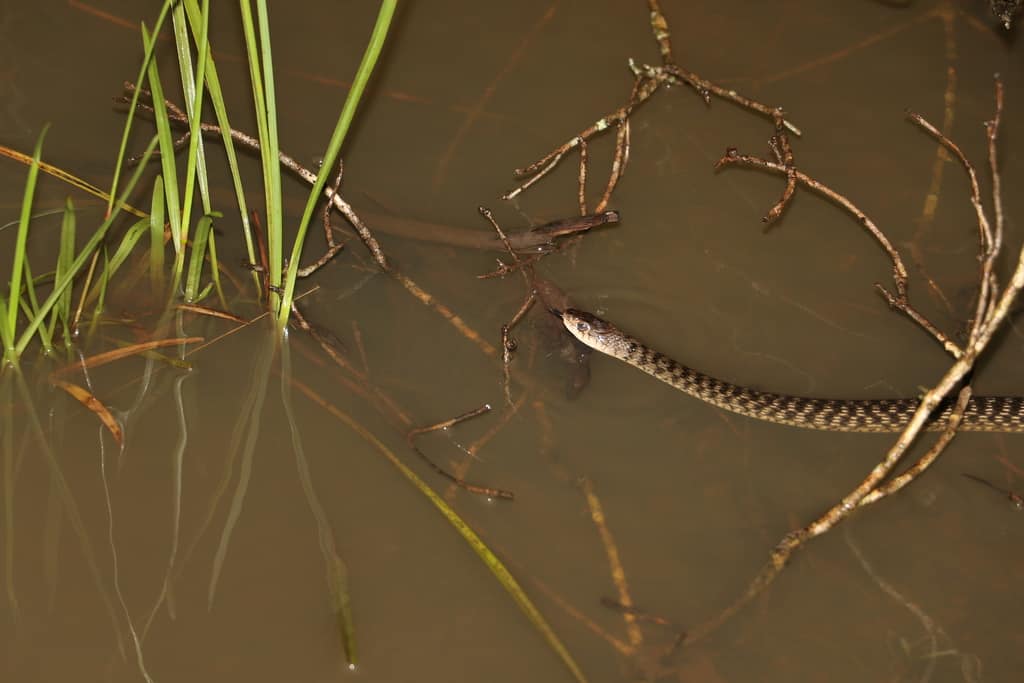
The other big frog-loving snake of eastern Australia. This species inhabits Queensland and northern New South Wales, lurking in swamps and submerging the moment it senses a human draw close. Sometimes they’ll blast to to the opposite side of the swamp at high speeds.
Tropidonophis mairii is non-venomous, and frogs and toads form their main prey. Unlike red-bellied black snakes, they are innately resistant to the invasive cane toad’s bufotoxins. They’re also resistant to native toxic amphibians like Dahl’s waterfrogs. In a study on 6 snakes, only the common keelback survived this meal. Black whipsnakes survived 12 hours, while death adders, children’s pythons and slatey grey snakes succumbed rapidly.
Common keelbacks might lack venom and aggression, but they have other weapons that other Aussie snakes can’t hope to compete with. Their Tropidonophis keelback family has occupied the frog niche for years, and their physiology has had plenty of time to adapt, to gradually become a finely tuned machine. Other confirmed prey of common keelbacks include ornate burrowing frogs and spotted grass frogs.
| 5 | Black forest racer |
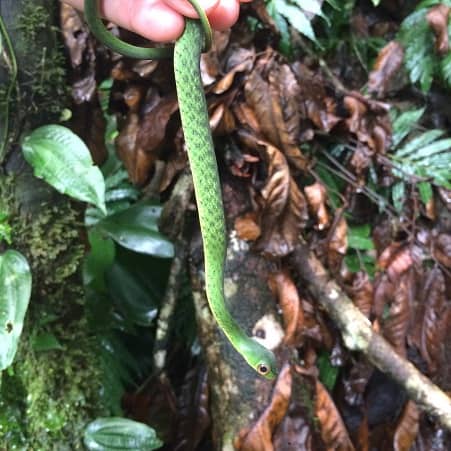
This central American species loves frogs so much that they swallow them in 2 minutes flat, and move onto others in the vicinity, their hunger unabated. Black forest racers (Drymobius melanotropis) inhabit northwest Costa Rica and Nicaragua. They’re non-venomous and reach a maximum of 123cm. They look kind of cute, with their round eyes and trustworthy expressions, but to frogs they’re their worst nightmare. There’s nothing adorable about their horribly magnified face approaching, and all frogs can do is hop for their lives, perhaps into the safety of a forest pool.
If the amount of frogs decline in a forest, the black forest racers will also decline, the two are so tightly intertwined. Black forest racers are active foragers, with fast reactions and an accurate lunge. They can climb trees, but mainly hunt on the ground, amid an alien world of rainforest creatures.
Their close cousin the speckled racer is equally addicted, with frogs and toads comprising 86% of their diet. Speckled racers live further north in Nicaragua, and feed on Mahogany tree frogs. All signs suggest that black forest racers reach similar proportions.
| 6 | Eastern ribbon snake |
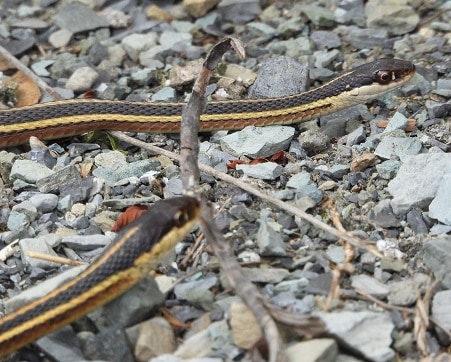
A semi-aquatic snake of the US northeast, including Ohio, Michigan, New York and Pennsylvania. Thamnophis sauritus is easily confused with the common garter snake, but is thinner-bodied and has a sharply bicolored face, dark above and cream below. Eastern ribbon snakes prefer slow or stationary water bodies, like ponds or pools adjacent to rivers, and they adore the taste of frogs.
According to a study on 557 ribbon snakes from Michigan, 90% of their prey consisted of amphibians. Favourites included the southern chorus frog, spring peeper, and northern leopard frog. They occasionally eat fish, but mammals are totally missing from their diet. Eastern ribbon snakes often appear near northern watersnakes in the northeast US, but the two don’t compete much, as northern watersnakes eat over 80% fish instead.
Eastern ribbon snakes especially love frogs, with small American toads (Anaxyrus americanus) and newts occasionally eaten. A New York state study was even more overwhelming at 100% of prey being amphibians, though with a smaller sample size of 22. Eastern ribbon snakes are active foragers, swimming around their ponds until their mouth latches onto something slimy. They’re not especially effective, but they get the job done. This is a common scenic countryside snake which means you no harm.
| 7 | Giant garter snake |
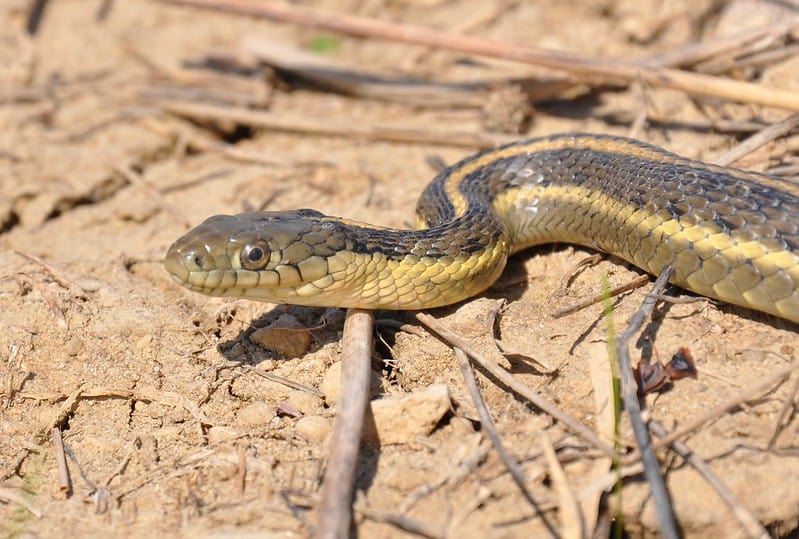
The USA’s most endangered garter snake, and also the largest. Giant garter snakes (Thamnophis gigas) prey primarily on frogs, with some fish. They only inhabit California, and just two regions: Sacramento Valley and San Joaquin valley. Giant garters are rare, but their surviving hotspots are perfect bases for frogs: manmade rice fields littered with water irrigation channels between them, which perfectly mimic their natural wetlands. Favourite prey include the Sierra tree frog, plus the invasive American bullfrog.
Giant garter snakes use a crafty strategy. Rather than chasing frogs around riverbanks, they find small pools in wetlands that are especially concentrated in frogs, and effortlessly swallow them up. It’s open mouth, swallow, open mouth, swallow, rinse and repeat.
Tests reveal that giant garters are highly attuned to Sierra tree frog scents, flecking their tongues excitedly when they approach. With non-native bullfrogs, they barely flecked their tongue, but gradually recognised them as prey over time. Giant garter snakes have never been recorded to eat a mammal, unlike the more flexible terrestrial garter snake. The frog world also bites back, as American bullfrogs are a top predator of juvenile giant garter snakes. Since they’re an invasive species, this is another reason why giant garter snakes are becoming extinct.
| 8 | Small-banded kukri snake |
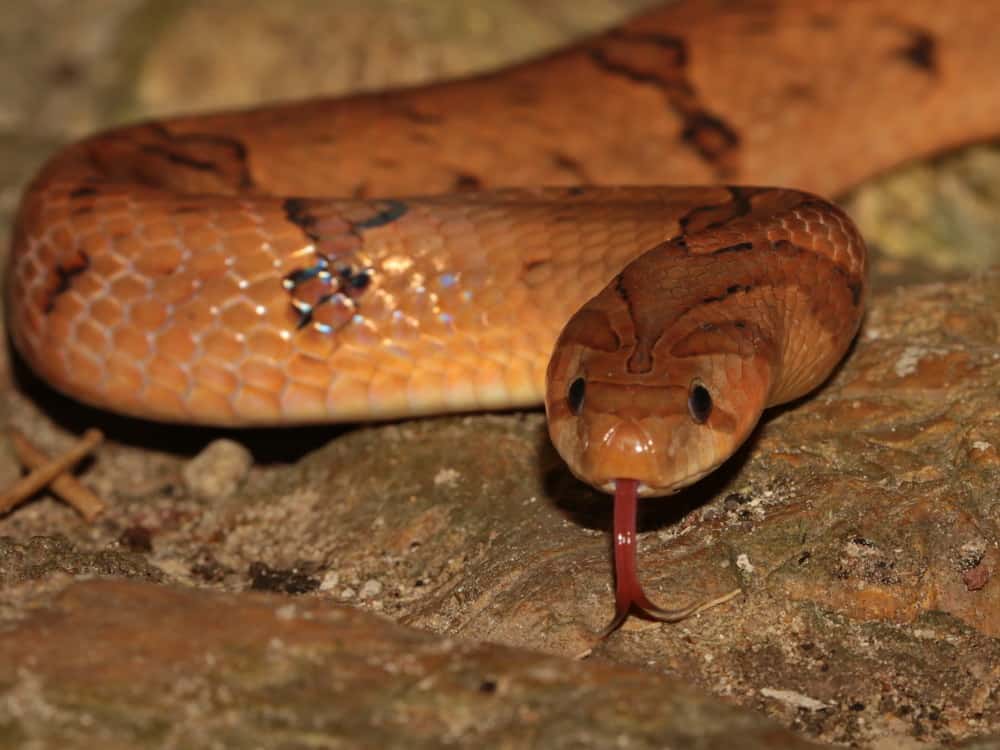
The most brutal toad/frog eating snake of all. This common Thai species is quite simply every frog’s worst nightmare. Small-banded kukri snakes also eat mammals and reptiles, but reserve their best for amphibians. Despite being non-venomous, Oligodon fasciolatus has an enlarged pair of front fangs, which were originally assumed to be for cracking eggs open. In 2016, a much more brutal purpose was revealed: stealing toads’ organs.
Oligodon fasciolatus first corners a toad, possibly a banded bullfrog or common Asian toad. Locations could be a pond in a hotel garden, or a stream by a meadow. The kukri snake slithers up, then delivers a laser accurate slash to the unsuspecting toad’s stomach. If successful, they must return for a second lunge, this time thrusting its head into the wound. Then they either swallow the organs with their head inside, or rip them out and eat them in a pile on the grassy ground. Hearts, livers, lungs and stomachs have been seen being ripped out.
More brutally, the frog can be alive well into this organ burglary. Sometimes, frogs can perform a heroic escape – there’s a reason they stay close to their trusted pools. Somehow, this kukri snake organ theft didn’t become official until 2016, although this snake keeper reported it unofficially in 2015.
| 9 | Black-banded keelback |
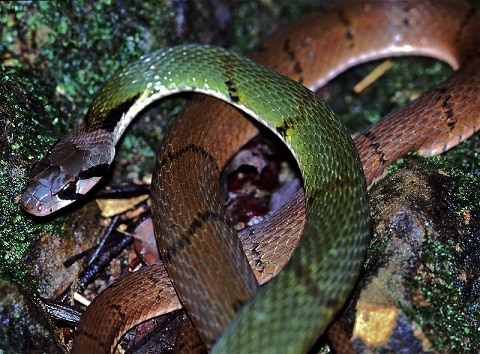
Part of Thailand’s amphibian control crew. Without about 10 predominantly frog-eating snakes, Thailand would be overrun with hopping and cricketing noises, and everyone would leave except for a few hermits determined to stay. One of these saviours is the black-banded keelback, found in all of Thailand except the far south, and also inhabiting Cambodia and Myanmar. This species has recognisable black eye stripes on its face and a colourful jungled appearance which would never be found in the desert.
The entire Rhabdophis keelback family is notorious for eating frogs and this species is no exception: they have a taste for the common Asian rice frog. Black-banded keelbacks are well-honed hunters, seizing the frogs by their hind leg first to prevent them from hopping away, deep into the sanctuary of a forest pool.
Black-banded keelbacks never inhabit towns, let alone cities. They’re a creature of deep forest streams, the ultimate location for frogs, shallow enough to hunt in, but with plenty of water for frogs to thrive (before getting eaten). Black-banded keelbacks are venomous but have never caused a known fatality in humans.
| 10 | Chinese garter snake |
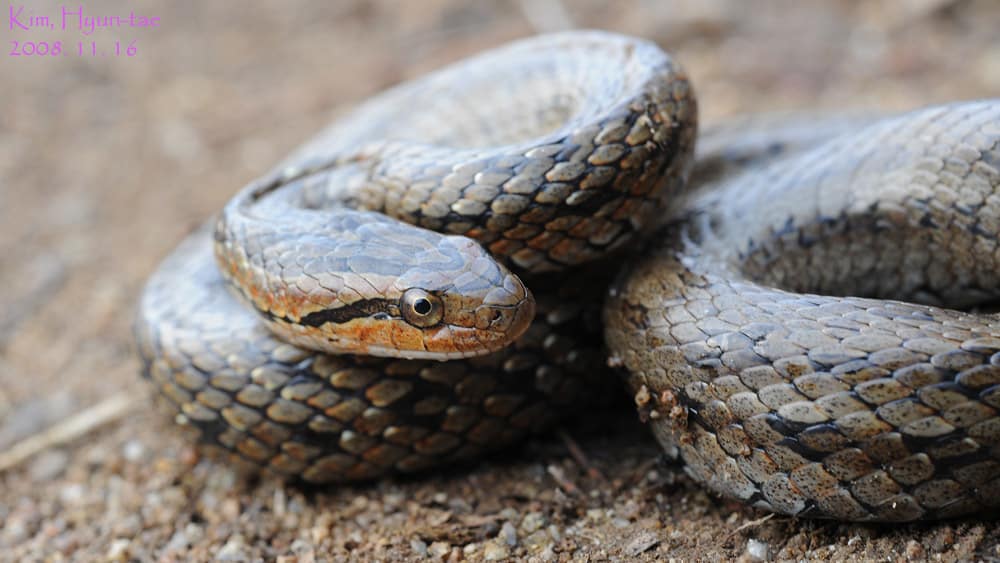
This Korean and southern Chinese species isn’t an actual garter snake, but has a bizarre resemblance to them. They’re actually the sole member of their genus: Oocatochus. Chinese garter snakes love ponds and lake shores, love peace and quiet, and most importantly, they love frogs (eating them anyway).
This 100cm snake eats amphibians, with a bonus helping of fish, and is very reluctant to eat rodents in captivity, unless they’re artificially scented with frog odours first. Their favourite native prey in Korea is the black-spotted pond frog. Chinese garter snakes aren’t fully aquatic; like a US garter snake, they switch between their cosy ponds and the well vegetated shores, overlapping perfectly with the frogs they’re hoping to swallow up. They mainly inhabit open, pristine countryside areas with rivers and lakes, like a Chinese version of Huckleberry Finn’s favourite stomping grounds. They avoid agriculture, except for rice paddies, which are perfect frog habitats.
Chinese garter snakes are under threat from an invader, and it’s the exact same as the giant garter snake: the American bullfrog, which has conquered the Korean peninsular, and loves the black-spotted pond frogs Oocatochus rufodorsatus relies on, adding competition. Oocatochus rufodorsatus also hunts American bullfrogs, but not as effortlessly as their beloved native prey.
